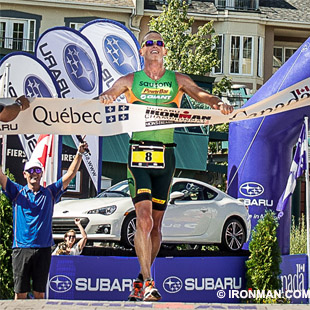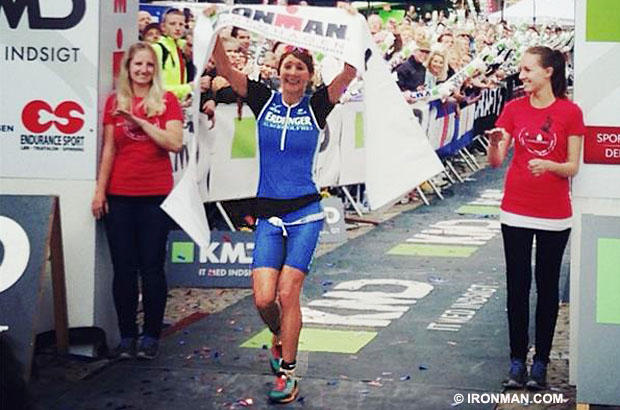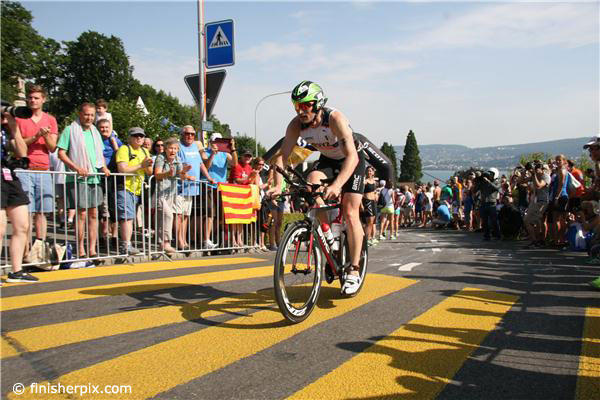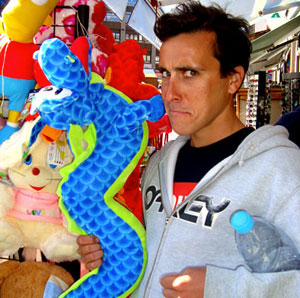On the bubble with Pedro Gomes
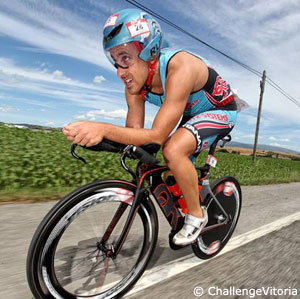
Portuguese Pro Pedro Gomes grabbed the win at Ironman Sweden and a few weeks earlier he won Challenge Vitoria Gasteiz. He is indeed improving quite nicely but he currently sits on the bubble of the KPR chase both in terms of points and also financially.
Slowtwitch: That was a fine performance in Sweden.
Pedro Gomes: Thanks Herbert! Definitely a very solid performance considering I was coming off a 6 week 'sail' having done already two full Ironman distance races during that period. I had to both recover and do a few long, harder sessions to keep my fitness high without having a major drop on my performances.
ST: You have been close before, but this year you have had a great season with a couple big wins so far.
Pedro: I’ve been close but usually it comes down to no cigar. I very rarely make the front swim pack on Ironman races and although I don’t lose that much time either, I’m usually chasing from T1 on. Labeled as a runner the actual chasing was always delayed to T2 and I was usually too far back to have a shot at winning just based off a fast run. It doesn’t really matter if I could run a sub 2:50 marathon if I am too far back. The past year was basically focused on bringing up my bike fitness to a whole new level where I could be closer to the front even if not on the lead swim pack. The rise of bike fitness reflected in some major bonks and slower overall run splits but a more leveled performance in the three sports.
ST: We assume you went to Sweden to get to Kona, and it looks somewhat likely that you punched a ticket.
Pedro: After a disappointing race at Ironman Texas – where I over did the bike, failed nutrition and faded on the run – my Kona plan fell off a bit. I did have a good race in Frankfurt but given the quality of the field present I was only 12th that day which gave me some points but far from what I needed. So I came to mid-July feeling fit but way back on points and settled not to race Kona. At the time I also thought it wouldn’t be worth going back to Kona without having some hope of making the first (or even second) swim pack. In Kona the swim is crucial and it’s just a lost race if you are not up there out of the water. That’s why I planned on doing two more Ironman distance races after Frankfurt – to take the most out of my current fitness and earn some money thinking already of 2014 and how I could be more competitive after another year of building up my swim. So going to Sweden was more a financial need than Kona points chase. However, I won the race, which brought me up to 4620 KPR points and – in theory – that should get me in. Given the current scenario I’m a bit more excited to go to Kona now as I had a brilliant swim in Sweden and it was quite a confidence boost as for where swim level is right now.

ST: During the race did everything just fall into place?
Pedro: Yes, I guess. I had to take some chances on the bike and run. I walked on a thin line between a major bonk and a great overall outcome. I was very lucky that everything fell in place and went my way. I kept a positive thinking and repeating to myself I would be fine if I kept my nutrition on time. I made zero nutrition mistakes and that is a huge part of any Ironman win. I did not have a perfect race, it never is but it was very close to it.
ST: Who were you most worried about going in?
Pedro: I took a peak at the starting list before the race and saw that there were no super-human athletes listed. No World Champions or sub-8hr guys, so I knew the field would be pretty leveled to my standards. I know David Plese (who eventually finished second) from Austria in 2012 and I saw he had a great race in Austria again this year, so he was definitely the more consistent performer coming into the race. Also Anton Blokin and Jarmo Harst have been very solid in their Ironman races, always starting with great swims and finishing off with strong runs. That reveals great control over their pacing and ability and those are always the strongest opponents. Other than these, a few others like Jonas Djurback (4th in 2012) and Karl-Johan Danilsson (fastest bike split in 2012) were racing at home and that’s always a huge boost of confidence so they could also pull out an ace on this years’ race.
ST: If Kona was your target all along and with you sitting outside of that KPR bubble, why race the Challenge Vitoria race versus another WTC race that would have given you points?
Pedro: To be honest, I love the race in Vitoria-Gasteiz. I had done it twice before being a Challenge race and would always show my support to it. However, it was not until Frankfurt that I was 100% sure that I would indeed race it (and finish) but it was a GO given the scenario where I abandoned the Kona plan. Due to the date and being the first year as a Challenge race, I knew my chances were higher. Vitoria-Gasteiz is worth for the destination. It’s a beautiful city, capital of the Basque Country and very eco friendly. I’ve raced a lot in Spain in the past and I’m always very welcomed in the country so I was really excited to go back, even if it didn’t have Kona points.

ST: That being said, that Challenge Vitoria Gasteiz race was you first Iron distance title. So what does this victory mean for you?
Pedro: It was very emotional. The ones that are closer to me know I’ve been struggling to keep up to the bar I set it on my debut official Ironman in Florida back in 2010 (where I finished 2nd after leading for most of the marathon). It’s easier to get to the top than to stay there and after that result I had a very hard time keeping up with it. I took some wrong paths out of tough situations, bad performances, a few injuries and it was the snowball effect. You lose confidence in yourself, the pressure is on and you just keep on making bad calls. After a year to forget – 2011 – I contacted Jesse Kropelnicki at QT2 Systems and slowly we started to work on my mindset and confidence. It took about a year – 2012 – to regain confidence and put me back in a good place. So the win in Challenge Vitoria was the culmination of a long period of absence where I had solid performance but never one I could be truly proud of. In Vitoria-Gasteiz I did my own race, alone for the entire day with only my own thoughts and it was a huge relief to come to the finish line in first. Relief because I proved to myself I could do it again and overcoming the past years with too many low points was worth it.
ST: Talk about that race.
Pedro: Racing in Vitoria-Gasteiz is always a thrill. The locals come out for the race and you’ll have tons of people cheering for you. The good thing about racing in Spain (opposed to other big crowds races) is that a lot of people know me from past racing so hearing my name and cheering me up is quite normal, even if I’m being chased by a battalion of the home country’s best. I came out of the water in third place and took the lead with 60-70km covered on the bike. Doing a solid, long effort like an Ironman is a lot about fighting off the bad thoughts that go through your mind. 'You are going to hard,' and 'this’ hurting too much.' It’s also a matter of pacing it right because you still have a marathon to run. So I led the field into T2 with the fastest bike split. There were some very strong runners behind me – Alejandro Santamaria had finished second in Mont Tremblant last year and had run a 2h48 marathon early in the year in Frankfurt – so the race wasn’t over. I was lucky to be able to sustain a solid pace throughout the marathon and finish off with a 13-min advantage. Racing a lot also helps you to know your limits and know how fast you can run given the level of pain you are going through. It will always hurt, it’s an Ironman and it’s an extremely tough event so you need to be very balanced with your pacing, nutrition and mindset.
ST: In terms of finish line atmosphere, does one clearly beat the other?
Pedro: Well Vitoria-Gasteiz was big but not a surprise. I had raced in Vitoria-Gasteiz before and I knew the locals are always very cheerful and massive on the finish line. However, hands down to everyone from Kalmar. I think these big races should always be in smaller communities – opposed to big cities – because it allows the town to be fully involved in the race. The run course in Kalmar goes through the entire downtown so everything stops to watch the race. In Vitoria-Gasteiz it would be quite impossible to do so as the city is way bigger. It would be unfair to compare races and Kalmar was quite a surprise. Both are so worth the trip.

ST: You mentioned QT2 earlier. How did that relationship get started?
Pedro: I started working with Jesse late in 2011. I first met Jesse in Texas early that year as a good friend – Jacqui Gordon – was working with him and talking wonders about his training methods and approach. In 2011 I had the above mentioned as year to forget so I decided to seek a new coach. I emailed a few of the most famous and it came down to two coaches. I asked a few other athletes their opinion and all pointed out Jesse as the best, under-rated coach. Jesse was working with a few pro athletes already – namely Cait and Tim Snow, Ethan Brown and Jacqui – but still fresh and starting his business with QT2 Systems. Jesse was fully comprehensive and totally receptive to take me on board and now I have to thank him for the opportunity.
ST: Is Jesse your main coach, or how is that set up?
Pedro: Jesse works only with a handful of pro athletes and is currently my coach. He’s also the founder of QT2 Systems and mentors the other QT2 coaches. QT2 Systems is a growing coaching service provider based out of Boston, MA, and currently works with people from all over the World! Jesse’s philosophy is passed along the other coaches and being the mastermind of the project means very few have the opportunity to work with him directly. To give out the best out of you as a coach you can’t be working on 50 athletes’ plan at the same time. If – for some reason – Jesse stops or can’t work with me anymore, I would still fully trust any of the other coaches working with QT2 Systems as I know both Jesse and Tim (Snow) pick the other coaches with true caution and care.
ST: Do you think that you now also have a different maturity level?
Pedro: Definitely. When I first started doing long distance races I was still fresh out of a couple of years racing ITU. Short course is all about being hungry and fearless while long course is more about being patient. My first long distance races I was being inpatient and fearless, I had no idea what I was doing; I just wanted to go faster. Sometimes it worked, sometimes I bonked hard. A great example of that is my Ironman Florida 2010 race, where I passed through the half-marathon mark in 1h18. Of course I hit the wall hard and couldn’t keep up with that pace. It was not very well thought but I was lucky it allowed me to finish 2nd. I could easily have faded to 3rd, 4th or 30th that day. Nowadays I know I need to be more patient and that eventually it will pay off. An Ironman race really starts at mile 18 on the run.
ST: How much of the year do you spend in the US versus at home in Portugal?
Pedro: This year it was a bit of an exception. I spent most of the early season in the US, from January to early June taking the most out of the great weather and training facilities Clermont, FL, offers. Considering we are in August and I’ve been racing a lot, I would say I’ve only spent a couple of weeks in Portugal this year. Training in Portugal is very hard, logistics here is tough to handle and you have very little options as to ride a bike. It’s a bit like living downtown Boston or New York, where you either drive an hour or two to find clear roads or you deal with traffic, lights and intersections for 20-30km. But the main reason why spent winter in the US this year was to avoid the rainy season in Portugal – it can rain for weeks in a row during the winter and if you add traffic and lack of care from the drivers, you’ll find yourself in very dangerous situations while on a bike. Considering about half the weekly training hours are spent on the bike, that’s a lot of time with your life at stake. There are great, closer places to train in Europe – such as Lanzarote or Fuerteventura – but it’s very expensive, almost as going to the US. Besides QT2 Systems had a camp in Clermont, FL, early this year and we had a very solid group of athletes training together. A squad environment is very helpful when you are flipping +30hrs a week, even if this’ an individual sport.

ST: So what is next?
Pedro: Kona would be next. I would like to make that a reality but I’m struggling with the trip costs. Although I just won two big races, I’ll have to wait a few weeks/months before the anti-doping control goes through and I see that coming in my bank account. Along with Jesse and QT2 Systems we’re trying to find solutions but for an European athlete, Kona is a $3K journey. Once I receive the invitation to Kona – meaning, I’ve qualified – I will have to make a decision based on what I have. If I can’t afford the trip, I will likely race another Ironman later in the year and start thinking of 2014. I don’t want to sound like I’m whining, I accept that it’s not easy for any pro athlete to afford all this trips – to qualifying races and then Kona – let alone me. It is what it is, I can be patient as right now whenever I ask for my account balance, my banks asks if everything is okay with me and offers me soup and bread.
ST: Should all things fall in place we would think that the ST gathering is a must do event for you.
Pedro: Yes! I’ve been to Kona and the ST gathering is always an ex libris of the Hawaiian journey. It’s like the underpants run or the Thank God I’m Not Racing party: you must go once to fully experience it. The raffle is always very generous – Quintana Roo last year gave out a frameset, SRM gave-out a complete powermeter systems, etc – and the house setting is usually very fancy with great hosts and food. Seeing or meeting everyone in Kona at the gathering is always super exciting.
ST: As we are talking about generous, is all well with sponsors?
Pedro: To be honest, I can’t say I have sponsors – as ones that pay bills or put food on the table. I have some performance bonuses, which are very helpful but always short to pay for travel and lodging expenses. QT2 Systems (and Jesse’s guidance) would be a sponsor as it doesn’t pay bills but they put me in a place where I can earn some money at races. I don’t want to sound ungrateful. I do have a great group of supporters, brands that give me the best products they have so I can perform and train at my best. I’ve been very lucky to be supported with top end products from FSA/Vision, Quintana Roo, Normatec, Fuel Belt, iBike, Athletes Lounge and Rudy Project. Without these I wouldn’t be able to compete or train almost full time. I accept that I’m still not in a position where I can rely only in this sport to survive but sponsors will come with results. I also understand that when a brand sponsors you, they need to get back something and there are still a few other athletes that are more worth investing on. What makes me sad is the lack of support from my own country. I carry Portugal’s name across the World, put the country on the map every time I race and sometimes win big races. Although Portugal is facing a tough financial crisis and it’s bad for every other 'amateur' sport we are any good at – rowing, judo, running, etc – I would still appreciate some encouragement. It is what it is – I won’t use it as an excuse to not give my best every day.
ST: Excuses won't help either way, so that is a good attitude.
Pedro: Every sport at a professional level is hard – adversity is part of the game we sign in for. We all know nothing comes easy and often the need to survive while still doing what you love makes you push harder and further.

ST: Hopefully we will see you in Kona.
Pedro: Hopefully, it would be very rewarding. Keeping my fingers crossed as for getting the qualifying spot and then being able to make the trip a reality. I've be literally on the road for almost 8 months now so even if I don't make it to the Big Island this year, I'll look at the bright side, spend a few more weeks at home and think that there's always 2014 and I'll have 12 more months to get ready for it! I'll be super bummed about missing the ST gathering though!


